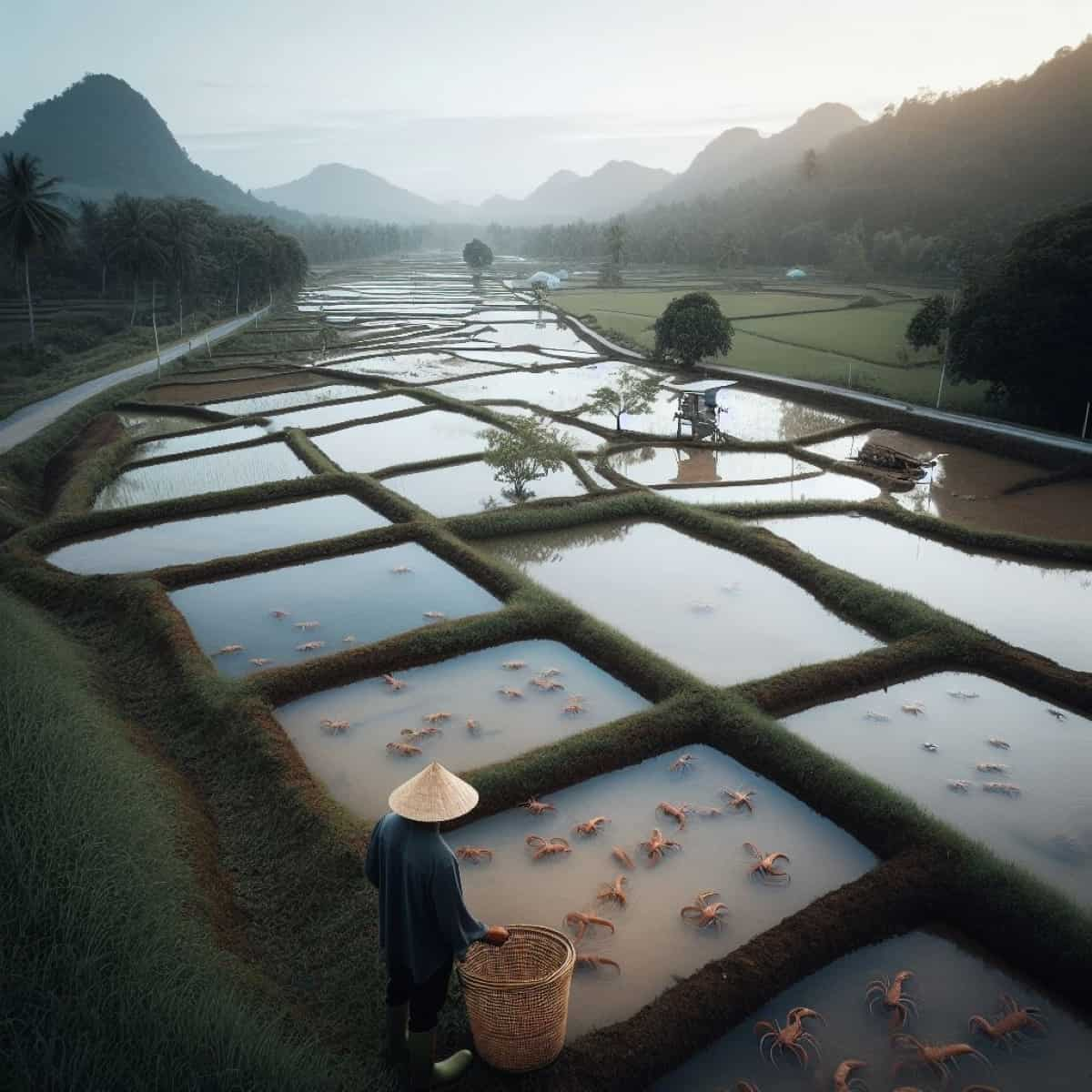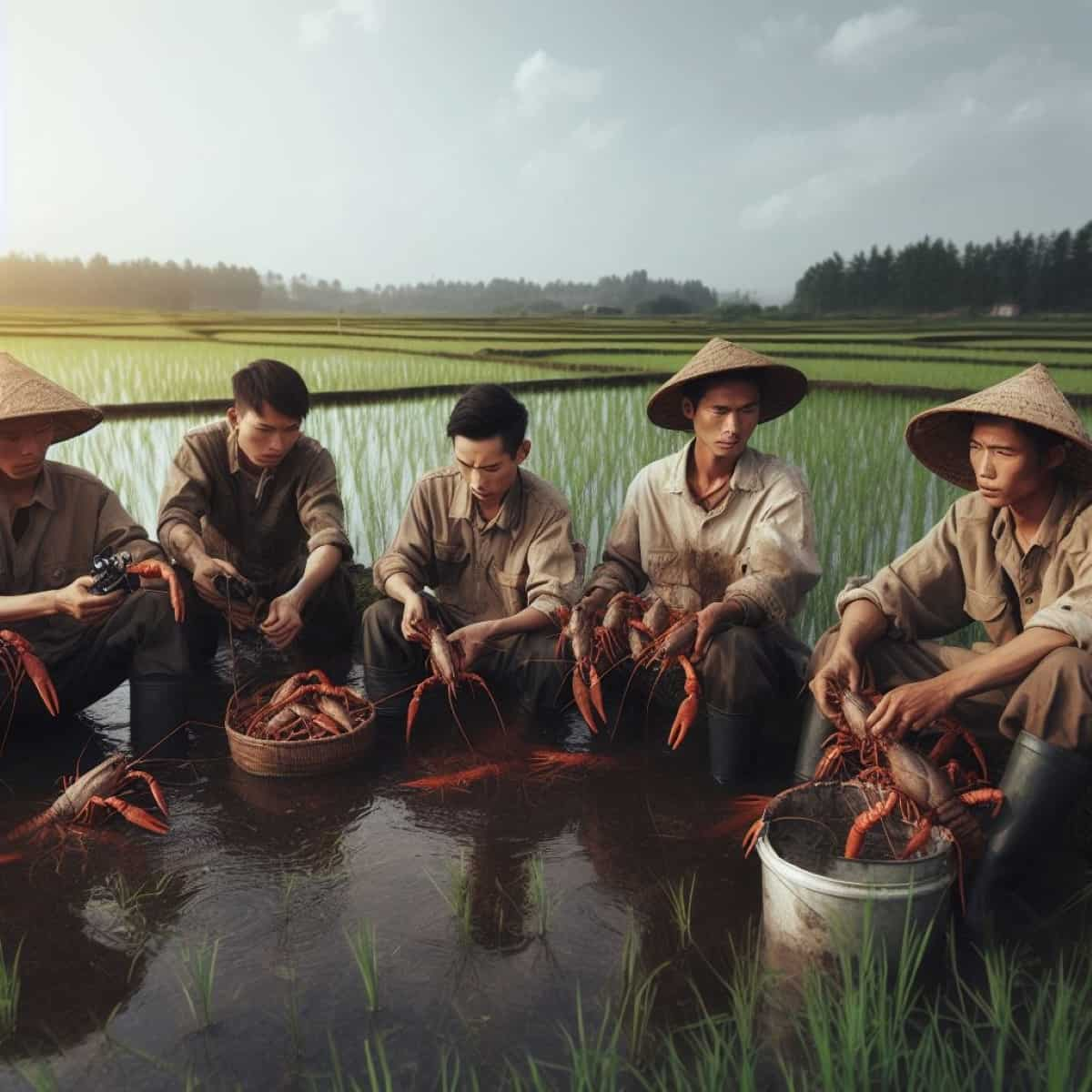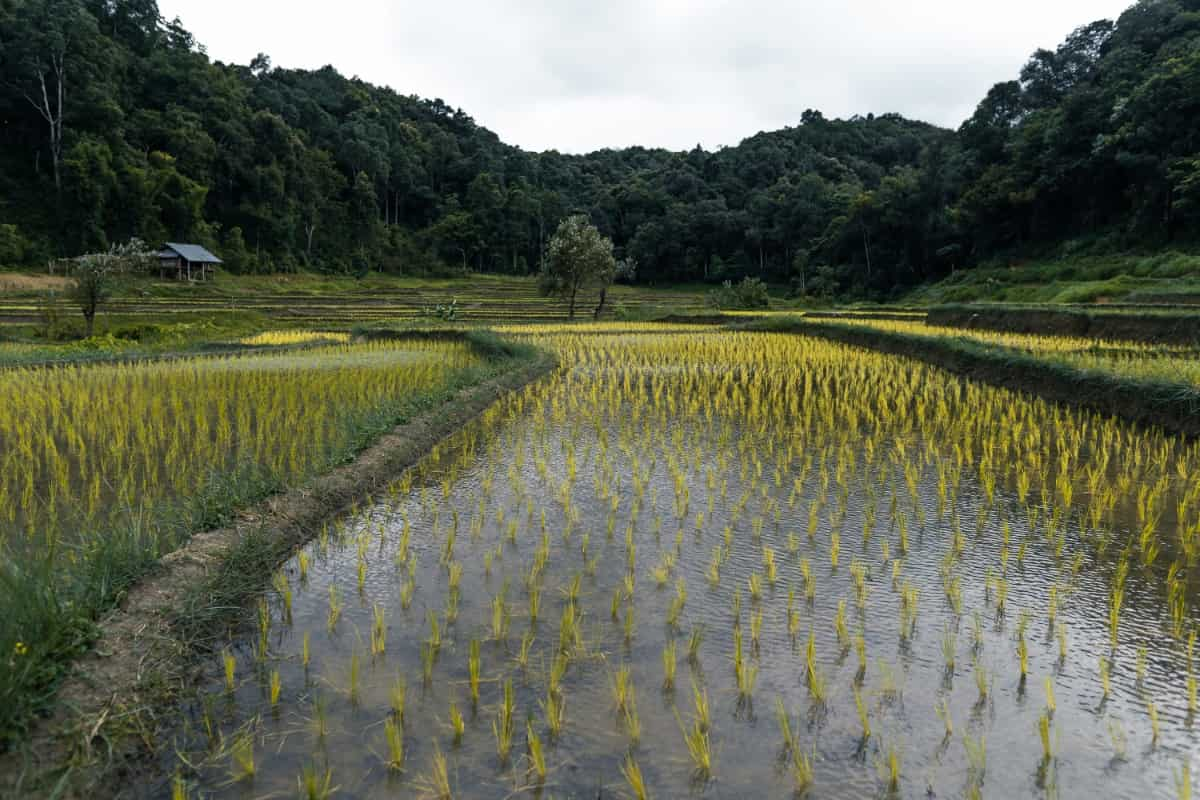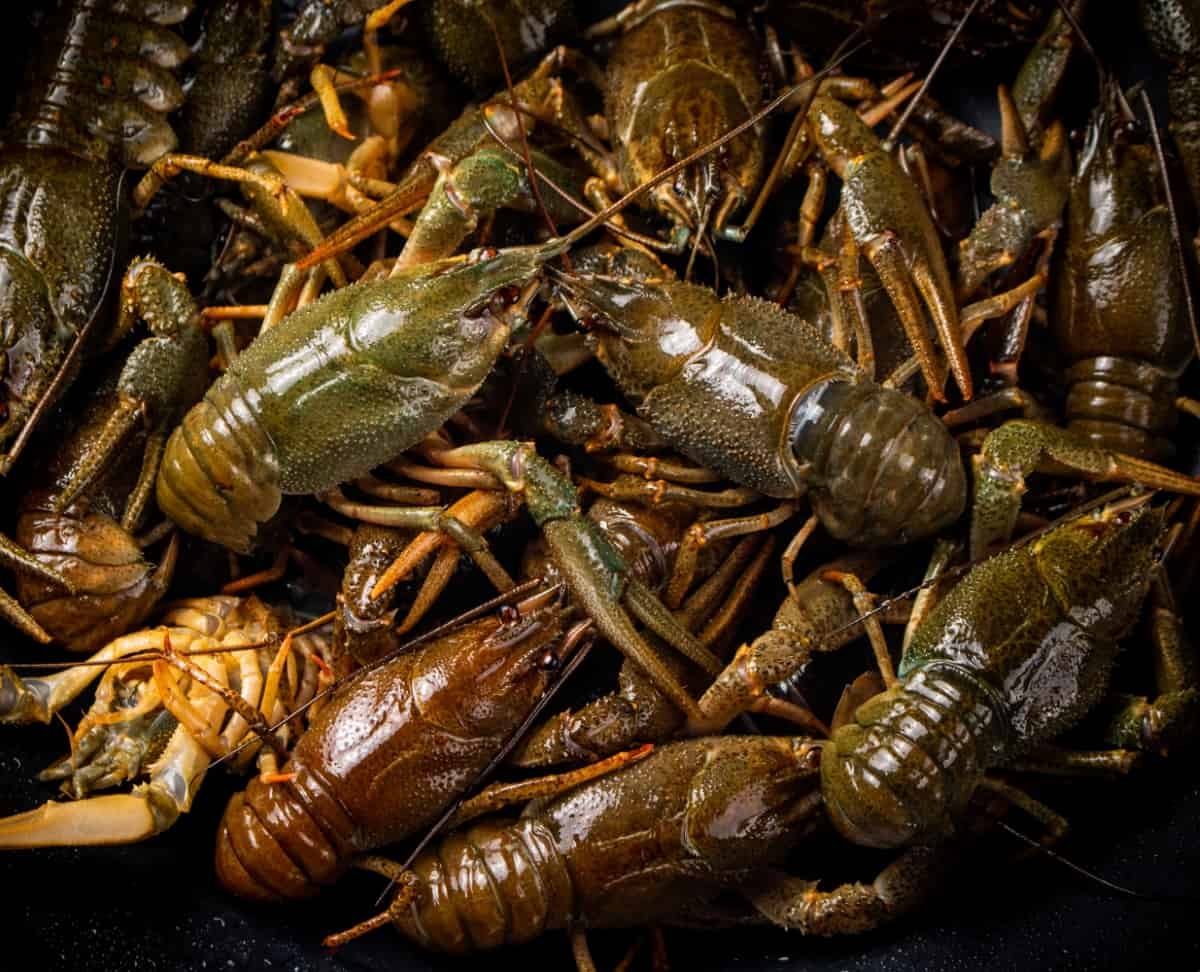In the world of farming, there’s a fascinating concept that’s been gaining attention: integrating rice cultivation with crayfish farming. It might sound unusual at first, but it’s a brilliant and sustainable method that holds great promise. This method not only increases crop yields but also helps promote biodiversity.

Rice-Crayfish Farming
What is Rice-Crayfish Farming Integration?
Rice-Crayfish Farming Integration is a clever farming technique where rice fields and crayfish ponds work together. Simply, it means growing rice and raising Crayfish in the same place. Rice provides a habitat for Crayfish, and Crayfish help control pests in the rice fields. This partnership boosts food production and helps the environment. It’s like two friends helping each other out to grow more food and support nature.
Benefits of Integrating Rice and Crayfish Farming Systems
Rice and Crayfish are two critical crops that can be grown together in a mutually beneficial way. Rice and crayfish farming systems, also known as rice-crayfish rotation or co-culture, involve planting rice in flooded fields and introducing Crayfish after the rice has emerged. The crayfish feed on the rice stubble, weeds, insects, and organic matter in the area while providing natural aeration and fertilization for the soil.
Increased income and diversification: Rice-crayfish farming systems can generate higher profits than rice monoculture, as Crayfish can fetch a high market price and demand. Crayfish can also provide an alternative source of income and food security in case of rice crop failure or low prices.
Reduced inputs and costs: Rice-crayfish farming systems can reduce the need for herbicides, pesticides, and fertilizers, as Crayfish can control weeds and pests and enrich the soil with their manure. This can lower the production costs and environmental impacts of rice farming.
Improved soil and water quality: Rice-crayfish farming systems can enhance soil structure and fertility by increasing the organic matter content, water-holding capacity, and microbial activity. Crayfish can also reduce the water turbidity and improve the water quality by consuming algae and suspended solids.
Enhanced biodiversity and ecosystem services: Rice-crayfish farming systems can create a complex and diverse habitat that supports a variety of aquatic and terrestrial organisms, such as fish, birds, amphibians, reptiles, insects, and plants. These organisms can provide valuable ecosystem services, such as pollination, pest control, nutrient cycling, and carbon sequestration.
Understanding the Ecological Interactions between Rice and Crayfish
Rice and Crayfish are two species that can coexist in the same ecosystem, but their interactions are complex and depend on various factors. Rice plants provide shelter and food for Crayfish, while Crayfish can help control weeds and pests that affect rice production. However, Crayfish can damage rice plants by burrowing, cutting, or uprooting them. Therefore, managing the balance between rice and Crayfish is crucial for achieving sustainable and profitable outcomes.
In case you missed it: Government Subsidy for Biofloc Fish Farming in India

Site Selection and Preparation for Rice-Crayfish Farming Integration
To choose the right spot, factors like soil quality, water source, and climate are crucial. The land should be level and suitable for rice cultivation. Preparing the site involves creating ponds for Crayfish and paddies for rice. Proper water management is essential, with channels to supply water to rice fields and ponds. These steps ensure a balanced ecosystem for rice and Crayfish, contributing to higher yields and sustainable farming practices.
Types of Rice-Crayfish Farming Integration
Rice-crayfish farming integration is a type of aquaculture that combines rice cultivation with crayfish production. There are two main types of rice-crayfish farming integration: Rotational and Concurrent. In rotational integration, rice and Crayfish are grown in alternate seasons, usually with rice in the summer and Crayfish in the winter. This allows the use of the same land and water resources for both crops and reduces the need for fertilizers and pesticides.
In concurrent integration, rice and Crayfish are grown together in the same field simultaneously. This creates a symbiotic relationship between the two species, as the crayfish feed on the weeds, insects, and snails that would otherwise harm the rice, and the rice provides shelter and oxygen for the Crayfish. Concurrent integration can increase the yield and quality of both rice and Crayfish and reduce labor and input costs.
Choosing the Right Rice Varieties for Integrated Farming Systems
Choosing suitable rice varieties for integrated farming systems is an important decision that can affect the productivity, profitability, and sustainability of the whole system. Rice varieties differ in their agronomic traits, such as yield potential, maturity, pest and disease resistance, and water and nutrient requirements. Indica Rice Varieties are suitable for rice-crayfish integration due to their adaptability to waterlogged conditions.
In case you missed it: Sustainable Biofloc Fish Farming: A Comprehensive Guide to Eco-Friendly Practices

High-yielding hybrid rice is right but must be compatible with crayfish habitat. Traditional or local rice varieties are better adapted to local environments. Flood-tolerant varieties are beneficial in integrated systems. Some types may also have specific quality attributes, such as aroma, taste, texture, and cooking characteristics, influencing consumer preferences and market demand.
Selecting Suitable Crayfish Species for Integration with Rice Farming
Crayfish species can be integrated into rice farming to boost productivity and profitability. However, not all species are suitable due to potential negative impacts on rice crops, environment, and biodiversity. Therefore, it’s crucial to choose species compatible with rice farming conditions like water quality, temperature, pH, salinity, and pest management. Factors to consider include growth rate, feeding habits, reproductive potential, susceptibility to diseases, compatibility with other aquatic organisms, and legal and regulatory status in the region.
Red Swamp Crayfish, Australian Red Claw Crayfish, and Marbled Crayfish are popular species for rice paddies due to their adaptability and high reproductive rate. Red Swamp Crayfish thrive in various water conditions, while Australian Red Claw Crayfish thrive in warmer climates. Marbled Crayfish reproduce without males, making them beneficial for maintaining populations in rice fields. Native crayfish species may have specific adaptations to local environments.
Water Management Techniques for Rice-Crayfish Farming Integration
Rice-crayfish farming is a sustainable practice that can increase crop yields and diversify income sources. Water management techniques are crucial for success, affecting rice and crayfish growth and health. Methods include maintaining a water depth of 10-15 cm during crayfish stocking and gradually increasing it to 20-25 cm during rice heading.
Adequate drainage and irrigation facilities are essential to control water levels and prevent flooding or drought. Organic or inorganic fertilizers enhance plankton production and provide food for Crayfish. Screens or fences are installed to avoid crayfish escape or predators. Harvesting Crayfish before or using traps or nets after harvest is also recommended.
Nutrient Management in Integrated Rice-Crayfish Farming Systems
Nutrient management for the success of integrated rice-crayfish farming systems, as they have different nutrient requirements that affect each other’s growth and health. Balancing inputs and outputs of nutrients like nitrogen, phosphorus, potassium, calcium, and organic matter is essential.
Practices include applying organic fertilizers, using appropriate chemical fertilizers, avoiding excessive pesticide use, providing supplemental feed for Crayfish during rice harvest season, and harvesting regularly to prevent overcrowding and nutrient depletion. These practices help maintain soil fertility and water quality and avoid overcrowding and nutrient depletion.
Pest and Disease Control Strategies in Rice-Crayfish Farms
Some of the common pests and diseases that affect rice-crayfish farms are rice water weevils, rice stem borers, crayfish plague, and bacterial soft shells. Control strategies are:
- Using resistant or tolerant varieties of rice and Crayfish
- Rotating rice and Crayfish crops with other crops that are not hosts for the pests and diseases
- Applying biological control agents such as predatory fish, insects, or microorganisms can reduce the pest and disease populations.
- Using chemical pesticides or antibiotics only when necessary and following the label instructions carefully.
- Monitoring the pest and disease levels regularly and taking action when the threshold is reached
In case you missed it: How to Start Fish farming in Israel: Business Plan, Key Rules, Cost, Profit, and Management

Harvesting and Processing Techniques for Rice and Crayfish in Integrated Systems
Integrated rice-crayfish farming systems, harvesting, and processing directly impact ecological and economic outcomes. This farming approach offers numerous benefits, such as increased food production, improved soil quality, reduced pests and weeds, and enhanced biodiversity.
Harvesting Techniques
Manual Harvesting: This method involves hand-picking Crayfish using nets, traps, or baskets. It’s suitable for small-scale farmers with a high market demand for live Crayfish. Manual harvesting can occur during the rice growing season or when water levels are low.
Mechanical Harvesting: Large-scale farmers may employ pumps, harvesters, or excavators to drain the field and collect Crayfish. This approach is cost-effective for large operations and is typically conducted at the end of the rice growing season.
Integrated Harvesting: This combines manual and mechanical methods to harvest rice and Crayfish simultaneously. It’s a balanced approach for farmers with moderate labor costs and demand for both products. Integrated harvesting is usually done at the end of the rice grown season when rice is ready for harvest.
Processing Techniques
Fresh or Live Product: This method involves sorting, grading, washing, and transporting rice and Crayfish to the market immediately after harvesting. It requires strict quality control, refrigeration, and hygiene standards. Fresh products are favored by consumers and retailers who prefer live or fresh food.
Processed or Value-Added Product: Here, rice and Crayfish are processed by cooking, drying, freezing, canning, smoking, salting, pickling, or other methods after harvesting. While it requires more processing, it demands less stringent quality control, refrigeration, and hygiene standards. Processed products cater to consumers and retailers who prefer value-added food options.
In case you missed it: 14 Biofloc Fish Farming Tank Suppliers in India: Top Aqua Products Manufacturers

Paddy Yield Impact of Rice-Crayfish Farming Integration
Rice-crayfish farming integration is a sustainable and profitable method for increasing paddy yield and conserving natural resources. Studies show that this practice increases yield by 9.8% in China, reduces chemical fertilizers and pesticides, and enhances soil organic matter and microbial activity. In Louisiana, USA, it increased output by 8.6% and improved soil health and water quality. These findings suggest that rice-crayfish farming integration is a sustainable and profitable approach to paddy production.
Environmental Impacts and Sustainability of Integrated Farming Systems
Integrated farming systems (IFS) are agricultural practices that aim to optimize the use of resources and reduce environmental impacts. IFS combines different types of crops, livestock, and agroforestry to create a more diverse and resilient production system. Some of the benefits of IFS include improved soil health, reduced greenhouse gas emissions, enhanced biodiversity, and increased food security.
However, IFS also needs help with challenges, such as higher labor and management costs, lack of technical knowledge, and market barriers. Therefore, it is essential to evaluate the sustainability of IFS from ecological, economic, and social perspectives.
Best Practices for Successful Rice-Crayfish Farming Integration
- Suitable Site Selection: Pick a convenient location with flat land for rice fields and ponds for Crayfish. Consider soil quality, water source, and climate.
- Suitable Rice Varieties: Choose varieties well-suited to your region and water conditions, such as Indica or flood-tolerant.
- Appropriate Crayfish Species: Select crayfish species that can adapt to rice fields, like Red Swamp Crayfish or Australian Red Claw Crayfish.
- Proper Water Management: Maintain water levels carefully. Rice fields need periodic flooding, while crayfish ponds should have a consistent water supply.
- Balancing Feeding: Crayfish can eat pests in the rice fields, but don’t let them overgraze. Supplement their diet if needed.
- Harvest Timing: Plan the harvesting of both rice and Crayfish wisely. Integrated or separate methods can be employed depending on your goals.
- Market Considerations: Know your market. Decide whether to sell fresh/live products, which have high demand but require quality control, or processed/value-added products, which may align with local preferences.
- Sustainability: Maintain a balanced ecosystem. Ensure that crayfish benefit from the rice fields and rice fields benefit from crayfish waste.
In case you missed it: Tilapia Fish Farming in Saudi Arabia: Business Plan, How to Setup Ponds and Tanks for Tilapia

Conclusion
Rice-crayfish farming integration is a sustainable and promising approach that enhances crop yields and biodiversity. This unique partnership offers multiple benefits, from increased food production to ecological balance. By carefully implementing best practices, we can ensure a harmonious coexistence between rice and Crayfish, paving the way for a more sustainable and bountiful agricultural future.
- Types of Pesticides Used in Agriculture: A Beginner’s Guide
- Economical Aquaculture: A Guide to Low-Budget Fish Farming
- 15 Common Planting Errors That Can Doom Your Fruit Trees
- How to Make Houseplants Bushy: Effective Tips and Ideas
- Innovative Strategies for Boosting Coconut Pollination and Yield
- Pollination Strategies for Maximum Pumpkin Yield
- The Complete Guide to Chicken Fattening: Strategies for Maximum Growth
- Natural Solutions for Tulip Problems: 100% Effective Remedies for Leaf and Bulb-Related Issues
- Revolutionizing Citrus Preservation: Towards a Healthier, Greener Future
- Natural Solutions for Peony Leaf and Flower Problems: 100% Effective Remedies
- Maximizing Profits with Avocado Contract Farming in India: A Comprehensive Guide
- Natural Solutions for Hydrangea Problems: 100% Effective Remedies for Leaf and Flowers
- The Ultimate Guide to Choosing the Perfect Foliage Friend: Bringing Life Indoors
- From Sunlight to Sustainability: 15 Ways to Use Solar Technology in Agriculture
- The Ultimate Guide to Dong Tao Chicken: Exploring from History to Raising
- The Eco-Friendly Makeover: How to Convert Your Unused Swimming Pool into a Fish Pond
- Mastering the Art of Delaware Chicken Farming: Essentials for Healthy Backyard Flocks
- 20 Best Homemade Fertilizers for Money Plant: DIY Recipes and Application Methods
- How to Craft a Comprehensive Free-Range Chicken Farming Business Plan
- Brighten Your Flock: Raising Easter Egger Chickens for Beauty and Bounty
- How to Optimize Your Poultry Egg Farm Business Plan with These Strategies
- Subsidy for Spirulina Cultivation: How Indian Government Schemes Encouraging Spirulina Farmers
- Ultimate Guide to Raising Dominique Chickens: Breeding, Feeding, Egg-Production, and Care
- Mastering the Art of Raising Jersey Giant Chickens: Care, Feeding, and More
- Ultimate Guide to Raising Legbar Chickens: Breeding, Farming Practices, Diet, Egg-Production
- How to Raise Welsummer Chickens: A Comprehensive Guide for Beginners
- How to Protect Indoor Plants in Winter: A Comprehensive Guide
- Ultimate Guide to Grow Bag Gardening: Tips, Tricks, and Planting Ideas for Urban Gardeners
- Guide to Lotus Cultivation: How to Propagate, Plant, Grow, Care, Cost, and Profit
- Agriculture Drone Subsidy Scheme: Government Kisan Subsidy, License, and How to Apply Online
- Ultimate Guide to Raising Araucana Chickens: Breed Profile, Farming Economics, Diet, and Care
- Bringing Hydroponics to Classroom: Importance, Benefits of Learning for School Students
- Ultimate Guide to Raising Polish Chickens: Breed Profile, Farming Economics, Diet, and Care
- Ultimate Guide to Raising Australorp Chickens: Profile, Farming Economics, Egg Production, Diet, and Care
- Silkie Chicken Farming: Raising Practices, Varieties, Egg Production, Diet, and Care
- Sussex Chicken Farming: Raising Practices, Varieties, Egg Production, Diet and Care